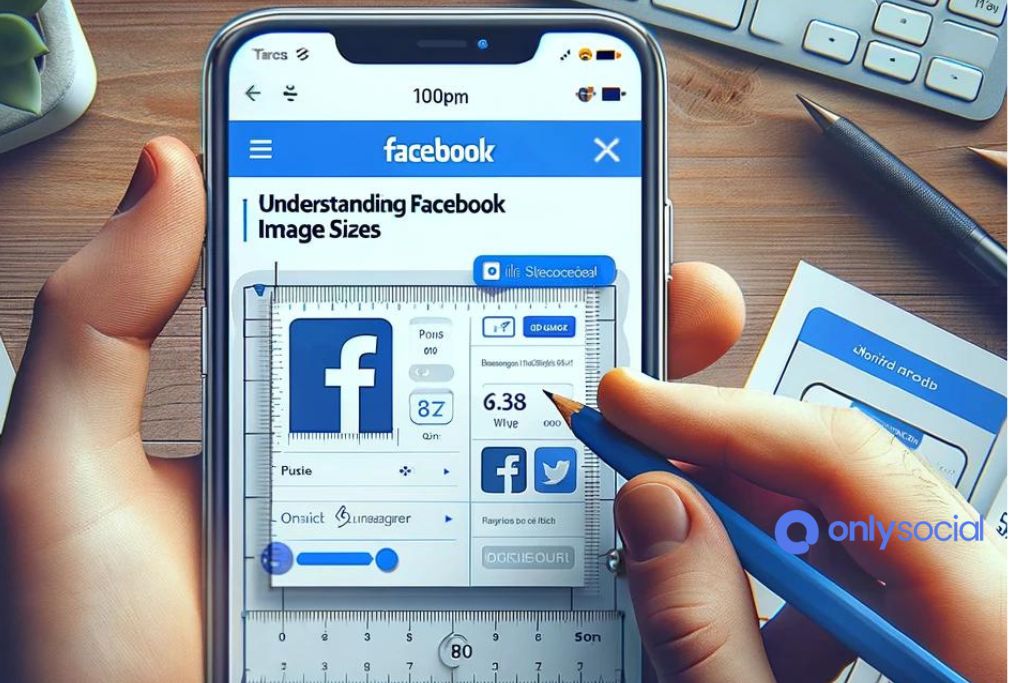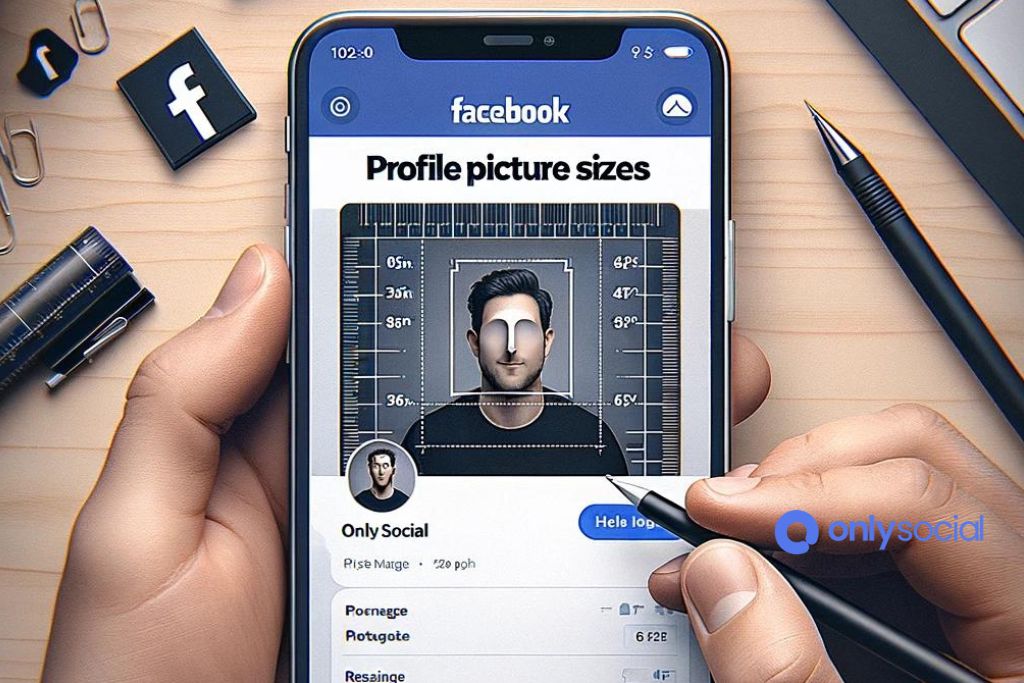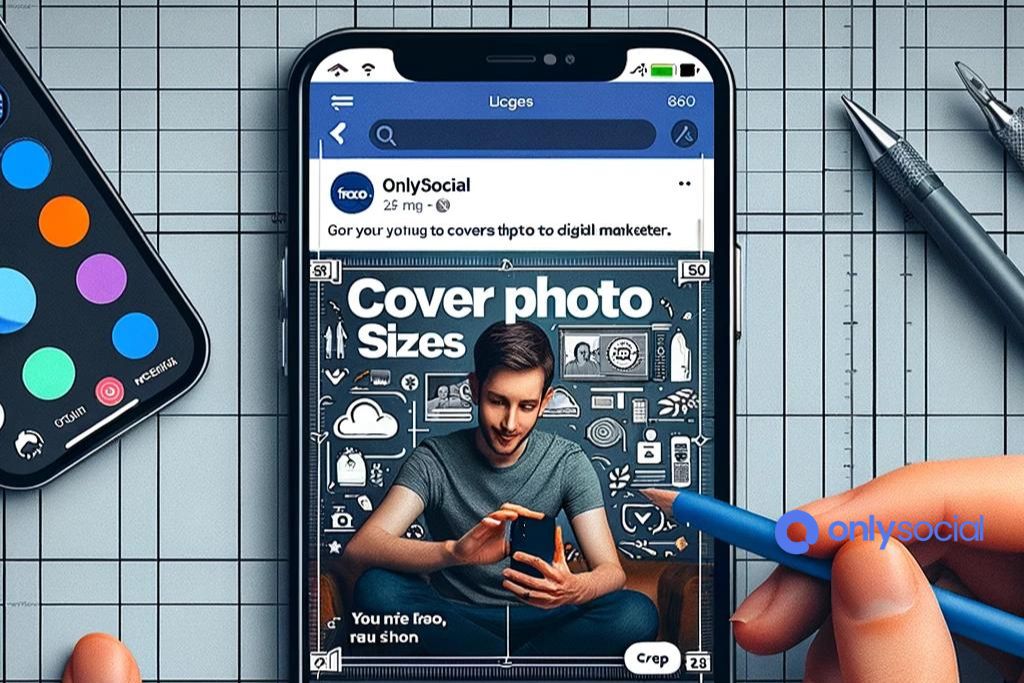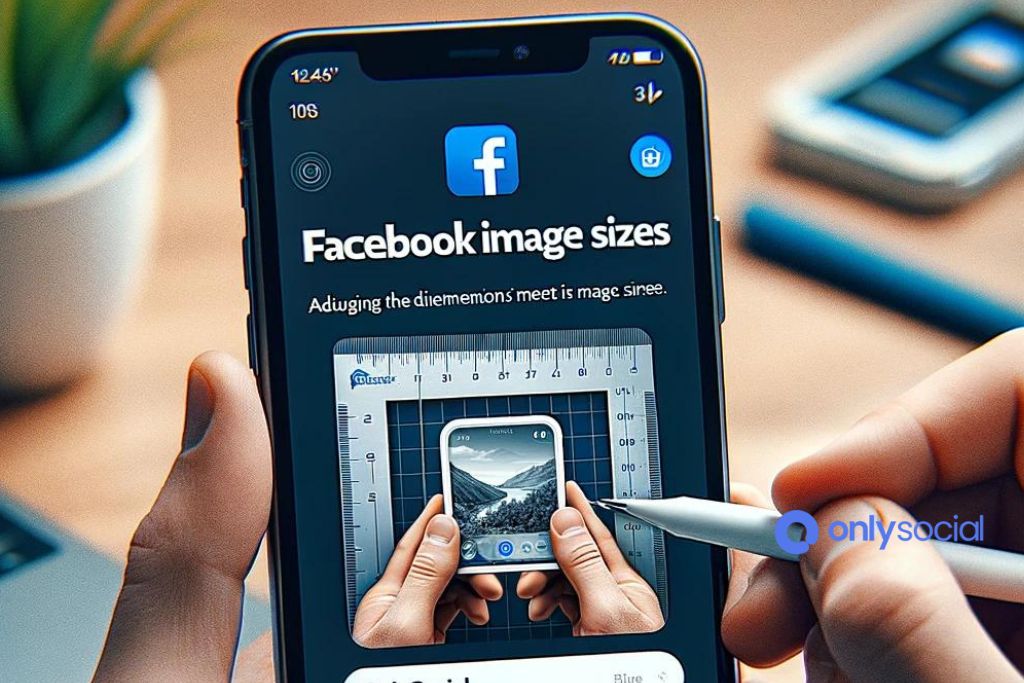In the visually driven world of social media, understanding and utilizing the optimal [Facebook Image Sizes] is crucial for anyone looking to make an impact. Whether you’re a business aiming to strengthen your brand presence, an influencer striving to connect with your audience or an individual sharing moments with friends and family, the dimensions of your images can significantly influence how your content is perceived and engaged with on Facebook. The right image sizes ensure that your photos and graphics appear clear, engaging, and professional, rather than pixelated or awkwardly cropped.
This guide delves into the significance of adhering to Facebook’s recommended image sizes and aspect ratios, providing a roadmap to perfecting your posts for maximum visibility and interaction. By mastering [Facebook Image Sizes], you can elevate your social media content, ensuring that every post looks its best and captures the attention it deserves.
Table of Contents
- 1 Understanding Facebook Image Sizes
- 2 Profile Picture Sizes
- 3 Cover Photo Sizes
- 4 Post and Timeline Photos
- 5 Event Cover Photos
- 6 Facebook Stories: Optimizing Your Visuals with the Right Facebook Image Sizes
- 7 Facebook Ads Image Sizes
- 8 Group Cover Photos
- 9 Tips for Perfect Facebook Posts
- 10 Common Mistakes to Avoid
- 11 BONUS
- 12 Frequently Asked Questions
Understanding Facebook Image Sizes

Understanding the correct Facebook image sizes is crucial for anyone looking to make an impact on this widely used social media platform. Whether you’re a marketer, a small business owner, or just someone looking to share content with friends and family, knowing the optimal dimensions for your images can greatly enhance how your posts are perceived and engaged with by viewers. Here, we delve into the specifics of Facebook image sizes, providing a clear guide to ensure your images look their best.
Profile Picture Sizes
Your profile picture represents you or your brand across the platform. It appears on your profile, next to comments you make, and in search results, making it one of the most critical images to get right.
- Optimal Size: 170 x 170 pixels on desktop, 128 x 128 pixels on smartphones.
Cover Photo Sizes
The cover photo is the large banner image at the top of your profile or page. It offers a significant opportunity to make a strong visual statement.
- Optimal Size: 820 pixels wide by 312 pixels tall on desktop, 640 pixels wide by 360 pixels tall on mobile devices.
Post and Timeline Photos
Images in posts and on your timeline can vary widely, but there are optimal sizes for these to ensure they display clearly without being cropped awkwardly.
- Optimal Size for Shared Images: 1200 x 630 pixels.
- Optimal Size for Shared Links with Preview Images: 1200 x 628 pixels.
Event Cover Photos
Event cover photos help capture the essence of your event, encouraging participation from viewers.
- Optimal Size: 1200 x 628 pixels, which translates to an aspect ratio of 1.91:1.
Facebook Stories
Stories are full-screen photos or videos that disappear after 24 hours, offering a more immersive viewer experience.
- Optimal Size: 1080 x 1920 pixels, maintaining an aspect ratio of 9:16.
Facebook Ads Image Sizes
Ad images vary depending on the ad format, but selecting the right size ensures your ad content is seen clearly and engagingly.
| Ad Format | Image Size (Pixels) | Aspect Ratio |
|---|---|---|
| Carousel | 1080 x 1080 | 1:1 |
| Single Image | 1200 x 628 | 1.91:1 |
| Video Ads | 1280 x 720 | 16:9 or 9:16 |
| Collection | 1080 x 1080 | 1:1 |
Group Cover Photos
Group cover photos set the tone for the group’s theme and are essential for fostering a sense of community.
- Optimal Size: 1640 x 856 pixels, which offers a more panoramic look.
Adhering to these recommended Facebook image sizes ensures your content looks professional, is displayed correctly, and can improve engagement with your audience. Always consider the platform’s frequent updates and test different image sizes to see what works best for your specific audience.
Profile Picture Sizes

When discussing Facebook image sizes, it’s crucial to start with one of the first elements anyone notices on a profile: the profile picture. This image represents you or your brand across the platform, appearing in search results, comments, and posts. Therefore, ensuring it’s the correct size and resolution is key to making a strong first impression.
Optimal Size for Profile Pictures
Facebook recommends uploading a profile picture with a size of 170×170 pixels on desktops, 128×128 pixels on smartphones, and 36×36 pixels for most feature phones. Profile pictures are displayed in a circular frame, so you must choose an image that fits well within these dimensions. The table below summarizes these recommendations:
| Device | Resolution (pixels) |
|---|---|
| Desktop | 170×170 |
| Smartphone | 128×128 |
| Feature phones | 36×36 |
Tips for Ensuring High-Quality Profile Images
- Use High-Resolution Photos: To avoid pixelation, start with a high-resolution image. Facebook automatically resizes and formats your photos when you upload them, but starting with a higher resolution (such as 800×800 pixels) can help maintain clarity.
- Center Your Subject: Since profile pictures are displayed in a circle, ensure the subject of your photo is centered so it doesn’t get cropped out.
- Consider Your Profile’s Public Appearance: Remember, your profile picture is public. Choose an image that aligns with how you want to be perceived by friends and potential contacts.
- Test Across Devices: Check how your profile picture looks on different devices (desktop, mobile, tablet) to ensure it appears as intended everywhere.
- Update Regularly: Keep your image current to reflect any significant changes in branding or personal appearance.
Understanding and adhering to the recommended Facebook image sizes for profile pictures ensures your image appears clear and professional across all devices, enhancing your presence on the platform.
Cover Photo Sizes

When discussing Facebook Image Sizes, understanding the correct dimensions for cover photos is crucial. Cover photos are the first impression users have when visiting a profile, page, or group, making their optimization essential for engagement. Below is a detailed guide to the optimal sizes for various types of cover photos on Facebook:
| Type | Recommended Size (Width x Height) | Aspect Ratio | Additional Notes |
|---|---|---|---|
| Profile Cover Photo | 851px x 315px | 2.7:1 | Ensure your image is at least 400px wide and 150px tall. For best results, upload an sRGB JPG file less than 100kb. |
| Page Cover Photo | 820px x 312px | 2.63:1 | Minimum size 400px x 150px. Higher resolution images will look better, especially on larger screens. |
| Group Cover Photo | 1640px x 856px | 1.91:1 | A larger size to accommodate the group name and other UI elements overlaid at the bottom. |
| Event Cover Photo | 1920px x 1005px | 1.91:1 | This size helps your event stand out and provides clarity for details in the event’s cover image. |
Guidelines for Cover Photos
- Quality and Composition: High-resolution images prevent pixelation and ensure your cover photos look professional. Pay attention to the composition, keeping in mind that Facebook will crop images based on the viewing device (desktop, mobile).
- File Type: JPG files are recommended for images with gradients and colors, while PNG files are better for images with text, logos, or detailed graphics to ensure clarity.
- Mobile Considerations: Design your cover photo with mobile viewing in mind. Since mobile displays will crop the sides, place important content (like text or key visual elements) towards the center.
- Profile Picture Interaction: Remember that your profile picture will overlap your cover photo at the bottom left on pages and profiles. Ensure that no critical information is obscured by the profile picture.
By adhering to these Facebook Image Sizes for cover photos, you can enhance the visual appeal of your Facebook profile, page, group, or event, ensuring a strong first impression and better engagement with your audience.
Post and Timeline Photos
Understanding the optimal Facebook Image Sizes for your posts and timeline photos is crucial for making your content stand out in your audience’s news feed. Here’s a detailed guide to help you navigate through the specifics:
Optimal Image Sizes for Facebook Posts
When uploading images to your timeline or creating posts, it’s important to adhere to the recommended dimensions to ensure your images display clearly and attractively across all devices.
| Type of Post | Recommended Image Size | Aspect Ratio |
|---|---|---|
| Standard Post Image | 1200 x 630 pixels | 1.91:1 |
| Shared Link Preview | 1200 x 628 pixels | 1.91:1 |
| Highlighted Image | 1200 x 717 pixels | 1.67:1 |
These dimensions help in avoiding pixelation or unexpected cropping, ensuring your images look professional and engaging.
How to Optimize Images for Engagement
1. Use High-Quality Images: Always opt for high-resolution images to avoid blurry or pixelated photos when viewed on any device.
2. Maintain Aspect Ratio: Stick to the recommended aspect ratios to ensure your images are displayed as intended without any important details being cut off.
3. Consider Mobile Users: With a significant number of users accessing Facebook through mobile devices, ensure your images look good on smaller screens. For instance, using a vertical or square format (aspect ratio of 4:5 or 1:1) can be more appealing in mobile feeds.
4. Test Different Image Types: Experiment with various types of images (e.g., infographics, quotes, behind-the-scenes shots) to see what resonates most with your audience.
5. Use Text Sparingly: While adding text to your images can be effective for conveying your message, too much text can detract from the visual appeal. Facebook also recommends minimal text on images used for ads.
Adapting to Facebook’s Algorithm
Facebook’s algorithm tends to favor content that generates more engagement. By optimizing your images according to the recommended Facebook Image Sizes, you’re more likely to see increased interactions from your audience. Additionally, engaging visuals can enhance your brand’s visibility and lead to higher click-through rates on your posts.
By adhering to these guidelines and regularly updating your strategy based on Facebook’s algorithm changes, you can ensure your posts and timeline photos are optimized for maximum impact.
Event Cover Photos
When organizing an event on Facebook, the cover photo is your first impression and plays a crucial role in attracting attendees. It’s essential to adhere to the recommended Facebook image sizes to ensure your cover looks professional and engaging across all devices.
Recommended Dimensions
For event cover photos, Facebook recommends using images with dimensions of 1920×1080 pixels. This aspect ratio of 16:9 is ideal for both desktop and mobile displays, ensuring that your image looks sharp and doesn’t get awkwardly cropped.
Designing for Visibility
- Center Focus: Keep the main elements of your design centered. Facebook sometimes crops images differently on mobile and desktop, so ensuring the focal point of your image is in the center prevents important details from being cut off.
- Text Placement: If your image includes text (e.g., the event name or date), place it near the center of the image. Avoid placing text too close to the edges to prevent it from being cropped out on different devices.
- Resolution Matters: High-resolution images are key. Even with the right dimensions, a low-resolution image can appear blurry or pixelated, reducing the impact of your event cover.
Template for Quick Reference
To make it easier, here’s a quick reference template you can use or provide to your graphic designer:
| Image Type | Recommended Size | Aspect Ratio | Notes |
|---|---|---|---|
| Event Cover Photo | 1920×1080 pixels | 16:9 | Center focal point; keep text and important visuals away from edges for best display on all devices. |
Optimizing for Engagement
- Use High-Quality Images: Choose clear, high-definition images that are visually appealing and relevant to your event.
- Branding: Incorporate your brand’s colors and logo subtly to make the event instantly recognizable to your followers.
- Test on Devices: Before finalizing, preview your cover photo on both desktop and mobile to ensure it looks great on all platforms.
Adhering to the recommended Facebook image sizes for event cover photos ensures that your event page is visually appealing and effectively communicates the essential details to your audience.
Facebook Stories: Optimizing Your Visuals with the Right Facebook Image Sizes
Understanding and utilizing the correct Facebook image sizes, especially for Facebook Stories, is crucial for creating engaging content that captures your audience’s attention. Here’s a detailed guide to help you optimize your visuals for Facebook Stories.
The Importance of Image Size in Facebook Stories
When it comes to Facebook Stories, using the right image sizes can make a significant difference in how your content is perceived. Stories are designed to be immersive and full-screen, which means any deviation from the recommended sizes can result in poor-quality visuals, such as pixelation or unwanted cropping.
Recommended Facebook Image Sizes for Stories
To ensure your images and videos look their best, follow these guidelines:
| Content-Type | Recommended Size | Aspect Ratio |
|---|---|---|
| Images | 1080 x 1920 pixels | 9:16 |
| Videos | 1080 x 1920 pixels | 9:16 |
These dimensions ensure that your content covers the entire screen without any quality loss or important details being cut off.
Tips for Creating Perfect Facebook Stories
- High Resolution: Always opt for the highest resolution possible within the recommended dimensions to ensure your content looks crisp and engaging.
- Aspect Ratio: Stick to the 9:16 aspect ratio to fill the screen properly. Content with different aspect ratios might be automatically adjusted, leading to potential quality issues.
- Text Placement: When adding text to your Stories, keep it centered and within the middle 60% of the screen to ensure it’s visible across all devices without being cut off.
- Test on Different Devices: Preview your Stories on various devices before posting to ensure they look good on different screen sizes and resolutions.
- Use Visuals Wisely: Given the quick, ephemeral nature of Stories, use compelling visuals that immediately grab attention. Keep your message clear and concise.
Leveraging Facebook Image Sizes for Engagement
By adhering to the recommended Facebook image sizes for Stories, you can create more engaging and visually appealing content. This not only enhances the viewer’s experience but also encourages higher engagement rates, as viewers are more likely to interact with content that looks good and feels immersive.
Remember, Facebook Stories are a powerful tool for connecting with your audience in a more personal and engaging way. By optimizing your image sizes, you’re taking an important step toward creating memorable and effective content
Facebook Ads Image Sizes
Understanding the correct Facebook Image Sizes for ads is crucial for marketers and advertisers aiming to maximize their impact and engagement rates. Here’s a detailed breakdown of the image dimensions recommended for various Facebook ad formats:
Facebook Ads Image Sizes
| Ad Format | Recommended Image Size | Aspect Ratio | Notes |
|---|---|---|---|
| Single Image Ads | 1200 x 628 pixels | 1.91:1 | Use high-resolution images for better performance. |
| Carousel Ads | 1080 x 1080 pixels | 1:1 | Each carousel card can feature a unique image, make sure they are uniform in size and quality. |
| Slideshow Ads | 1280 x 720 pixels | 16:9 (landscape) or 1:1 (square) | Images should be consistent in size to prevent cropping. |
| Collection Ads | 1200 x 628 pixels | 1.91:1 | The cover image or video plays a crucial role in attracting attention. |
| Instant Experience Ads | 1080 x 1920 pixels | 9:16 | Full-screen experience, images should be optimized for fast loading. |
| Lead Generation Ads | 1200 x 628 pixels | 1.91:1 | Visuals should be relevant to the product or service offered. |
| Video Ads | Thumbnail – 1200 x 675 pixels | 16:9 | Ensure the thumbnail is clear and engaging, even without text. |
| Messenger Inbox Ads | 1080 x 1080 pixels | 1:1 | Appears in the Messenger inbox, should be engaging and clear. |
| Sponsored Messages | 1200 x 628 pixels | 1.91:1 | Personalized messages that appear directly in a user’s Messenger inbox. |
| Marketplace Ads | 1200 x 628 pixels | 1.91:1 | Images should clearly showcase the product or offer to entice clicks. |
Tips for Optimizing Facebook Ad Images
- Consistency is Key: Ensure your images maintain a consistent style to improve brand recognition.
- Quality Over Quantity: Use high-resolution images to avoid pixelation on various screen sizes.
- Text Consideration: Minimize text on images; Facebook recommends using less than 20% text on ad images.
- Test Different Images: A/B test different images to see which performs best with your target audience.
- Mobile Optimization: Since a significant portion of users access Facebook via mobile, ensure your images are optimized for mobile viewing.
By adhering to the recommended Facebook Image Sizes for ads, advertisers can improve the visual appeal and effectiveness of their campaigns, ensuring that their message reaches the intended audience in the most engaging way possible.
Group Cover Photos
Optimizing your Facebook group cover photo is crucial for making a strong first impression on new members and keeping the existing ones engaged. The group cover photo is one of the most noticeable elements when someone visits your group page. Therefore, it’s essential to adhere to the recommended Facebook image sizes to ensure your cover looks professional and communicates the group’s essence effectively.
Recommended Facebook Image Sizes for Group Cover Photos
| Element | Recommended Size | Aspect Ratio |
|---|---|---|
| Group Cover Photo | 1640 x 856 pixels | 1.91:1 |
Tips for Designing Group Cover Photos
- Ensure Clarity and Focus: The group cover photo should clearly represent the theme or purpose of your group. Use high-resolution images to avoid pixelation when viewed on different devices.
- Consider the Desktop and Mobile View: Facebook crops group cover photos differently on mobile and desktop. Ensure that your important content (like text or key visuals) is centered to avoid being cut off.
- Use Text Sparingly: While it might be tempting to add a lot of text to convey your group’s message, too much text can make the cover photo look cluttered, especially on smaller screens. If you must use text, ensure it’s readable across all devices.
- Update Regularly: Keep your group’s look fresh and aligned with any theme changes, upcoming events, or seasons. Regular updates can keep engagement high and make the group feel active and inviting.
- Compliance with Facebook’s Guidelines: Ensure your cover photo adheres to Facebook’s community standards and copyright laws. Using copyrighted images without permission can lead to your photo being removed or your group facing penalties.
Adjusting Your Group Cover Photo to Fit Facebook Image Sizes
- Cropping Tools: Use Facebook’s built-in cropping tool to adjust your cover photo upon uploading. This tool helps you center the image’s focus point and ensures that key elements are visible.
- Image Editing Software: Before uploading, use image editing software to pre-crop or adjust your photo to the recommended dimensions. This step can help you control the final appearance of your image on Facebook.
- Test on Multiple Devices: After uploading your group cover photo, check how it appears on different devices (desktop, mobile, tablets) to ensure the image is displayed correctly across all platforms.
By adhering to the recommended Facebook image sizes for group cover photos, you can create a visually appealing and cohesive look for your Facebook group, enhancing the overall user experience for your members.
Tips for Perfect Facebook Posts
When crafting Facebook posts, the visual component plays a significant role in capturing the attention of your audience. Here are tips to ensure your posts are visually appealing and correctly formatted, with a particular focus on optimizing Facebook image sizes.
Choose the Right Dimensions
- Profile Pictures: 170 x 170 pixels on desktop, 128 x 128 pixels on mobile.
- Cover Photos: 820 x 312 pixels on desktop, 640 x 360 pixels on mobile.
- Post Images: 1200 x 630 pixels for the best display on high-resolution devices.
- Event Cover Photos: 1200 x 628 pixels.
- Ad Images: Varies by ad type, but typically 1080 x 1080 pixels for square ads.
Maintain Aspect Ratios
| Content Type | Recommended Aspect Ratio | Notes |
|---|---|---|
| Profile Picture | 1:1 | Square shape ensures consistency across devices |
| Cover Photo | 2.7:1 | Wider images work better for cover photos |
| Post Images | 1.91:1 to 1:1 | Varies depending on the post type |
| Event Cover Photos | 1.91:1 | Ideal for visibility in event listings |
| Ad Images | 1:1 (Square) or 9:16 (Stories) | Choose based on the ad’s placement and objective |
Optimize Image Quality
- Use High-Resolution Images: Ensure your images are high resolution to avoid pixelation, especially important for Facebook image sizes when viewed on different devices.
- Compress Files: Use image compression tools to reduce file size without sacrificing quality, speeding up load times.
Design with Mobile in Mind
- Test on Mobile Devices: Since most users access Facebook on mobile, design your images to look good on smaller screens.
- Centralize Key Elements: Keep important details in the center of the image to avoid cropping.
Use Text Wisely
- Minimal Text on Images: Facebook prefers images with less text for ads. Use the text overlay tool to check your ad images.
- Readable Fonts: Choose large, legible fonts for any text on your images.
Test and Learn
- A/B Testing: Experiment with different image sizes and formats to see what performs best with your audience.
- Stay Updated: Facebook occasionally updates its platform and image size recommendations. Stay informed to ensure your images always look their best.
By following these tips and focusing on the optimal Facebook image sizes, you can create posts that are visually appealing and effectively engage your audience.
Common Mistakes to Avoid
When working with Facebook image sizes, it’s easy to fall into certain traps that can affect the visual appeal and effectiveness of your posts. Being aware of these common mistakes can help you maintain the quality and engagement of your content.
| Mistake | Description | How to Avoid |
|---|---|---|
| Using Incorrect Sizes | Uploading images that don’t meet the recommended Facebook image sizes can lead to cropping or stretching, affecting how your content is displayed. | Always refer to the latest guidelines on optimal image sizes for different types of Facebook posts. |
| Ignoring Aspect Ratios | Not considering the aspect ratio can result in important parts of the image being cut off in the display. | Ensure that your images follow the recommended aspect ratios for each type of post to avoid unwanted cropping. |
| Overlooking Mobile Optimization | Forgetting that a significant portion of users access Facebook via mobile devices. This can lead to images looking different on mobile screens. | Test how your images appear on both desktop and mobile devices to ensure they look good on all screens. |
| Compromising Image Quality | Reducing image file size too much to meet upload requirements, resulting in loss of clarity and detail. | Use compression tools that reduce file size without significantly affecting image quality. Opt for the right balance between size and quality. |
| Neglecting Profile and Cover Photo Updates | Using outdated or low-resolution images for profile and cover photos, which are crucial for first impressions. | Regularly update your profile and cover photos with high-resolution images that comply with the recommended dimensions. |
| Overusing Text in Images | Adding too much text to an image, especially for ads, which Facebook might penalize by limiting the reach of the post. | Follow Facebook’s text-to-image ratio guidelines, especially for ads, to ensure your content reaches your intended audience. |
| Failing to Adapt to Changes | Not staying updated with Facebook’s changes in image size recommendations. | Keep an eye on any announcements or updates from Facebook regarding image sizes and adjust your content strategy accordingly. |
Avoiding these mistakes will help ensure that your Facebook posts are visually appealing and reach your target audience effectively. Always keep the focus on creating content that looks good and adheres to Facebook’s guidelines for image sizes.
BONUS
Navigating the ever-changing landscape of Facebook’s image requirements can be a daunting task. Whether it’s for your profile picture, cover photo, posts, or ads, knowing the right dimensions ensures your content looks its best on everyone’s feed. High-quality, well-formatted images are essential for grabbing attention and engaging your audience effectively.
To optimize your social media management, consider using OnlySocial’s Post Planning and Scheduling function. This tool streamlines the process of planning and posting to all social networks, ensuring your images meet platform-specific requirements. With OnlySocial, you have the freedom of unlimited posting across an unlimited number of social profiles, making it easier to maintain a consistent and professional online presence. Take advantage of our commitment-free 7-day trial today.
Frequently Asked Questions
What happens if I use the wrong image size for my Facebook post?
Using the wrong image size can lead to several issues, such as your image being cropped unexpectedly, looking stretched or pixelated, or not displaying as intended on different devices. This can affect the visual appeal of your post and potentially reduce engagement with your audience. It’s crucial to follow Facebook’s recommended image sizes to ensure your content looks its best.
Can I use the same image size for all types of Facebook posts?
No, Facebook recommends different image sizes and aspect ratios for various types of posts, such as profile pictures, cover photos, timeline images, stories, and ads. Each type of image has specific dimensions that optimize how it’s displayed on the platform. Using the correct size for each post type will ensure your images look clear and are properly formatted for viewers.
How often does Facebook change its recommended image sizes?
Facebook may update its recommended image sizes and guidelines periodically to improve user experience or accommodate changes in technology and device screen sizes. It’s important to stay informed about these updates by checking Facebook’s official resources or reputable marketing blogs that track these changes. This way, you can adjust your content strategy as needed to ensure your images continue to look great on the platform.
Are there any tools to help resize images for Facebook?
Yes, there are several online tools and software applications designed to help resize images for Facebook, ensuring they meet the platform’s recommended dimensions. Some popular options include Canva, Adobe Spark, and PicResize, among others. These tools often offer pre-set templates for social media posts, including specific options for Facebook, which can simplify the process of resizing your images correctly.
Does the image file format affect how it appears on Facebook?
While Facebook supports various image file formats, including JPEG, PNG, GIF, and others, the platform prefers certain formats for optimal display. JPEG is typically recommended for most photos due to its balance of quality and file size, while PNG is better for images with text or transparent backgrounds. Using the appropriate file format can help ensure your images look clear and load quickly on Facebook.
How can I prevent my Facebook cover photo from being cropped on different devices?
To prevent your Facebook cover photo from being cropped on different devices, ensure you use the recommended dimensions and keep the most important elements of your image within the safe zone. Facebook’s current recommended size for cover photos is 820 pixels wide by 312 pixels tall on desktops and 640 pixels wide by 360 pixels tall on smartphones. Design your cover photo so that the essential elements (like text or logos) are centered and not too close to the edges.
What is the best resolution for Facebook photos to avoid pixelation?
For the best quality and to avoid pixelation, Facebook recommends uploading images with a resolution of at least 1080 pixels wide. For profile pictures and cover photos, using higher resolution images is beneficial, as long as the file size does not exceed Facebook’s uploading limits. High-resolution images will look clearer and more professional on your profile or page.
Can I use vertical images for Facebook posts, and what are the best dimensions?
Yes, you can use vertical images for Facebook posts. While horizontal images are more common, vertical images can capture attention in the news feed. The best dimensions for a vertical image on Facebook are a 4:5 aspect ratio, with a recommended size of 1080 pixels wide by 1350 pixels tall. This size ensures that the image displays well without being cropped in the news feed.




